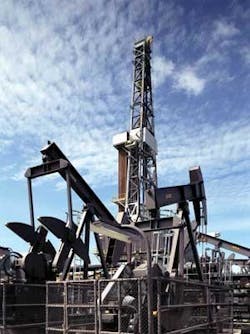Wytch Farm wireless wellhead monitoring network self-organizes
The smart, self-organizing, wireless transmitters installed recently in Wytch Farm field provide for continuous monitoring of wellhead pressures, thereby eliminating the need for operations personnel to read manually wellhead pressure gauges.
Continuous monitoring eliminates these daily visits to the wellheads and enables operators to identify earlier unusual readings and take action to investigate and rectify faults before they develop into serious problems, according to Emerson Process Management, the company that furnished and installed the network.
BP PLC operates the field from onshore facilities (see photo) that produce from three separate reservoirs that extend offshore under Poole Harbour and Poole Bay, Dorset County, England.
Wireless network
As part of a drive to improve operations, BP says that it wanted to increase the available information, improve worker efficiency, and remove the need for operator rounds.
“Manual reading of pressure gauges on the wellhead was identified as one area we could improve, but we found that wired transmitters were simply too expensive due to the wiring infrastructure needed, so wireless is the perfect technology for this application,” explained Chris Geen, BP manager,
The smart wireless network installed on one wellsite at Wytch Farm includes 40 wireless Emerson’s Rosemount pressure transmitters.
Mounted on each wellhead are two transmitters. A single smart wireless gateway, mounted outside the process area, connects the transmitters to the control system.
BP collects the data in a PI historian database from which the collected data provide information for regular maintenance activity and safety reports.
Emerson says installation was quick and easy. The work involved isolating the manifold; removing the old dial gauge, and screwing in the wireless transmitter into an existing connector.
The company notes that despite short access periods to the site, it took less than 8 hr, spread over 2 days, to complete installation at the site, including a three-point manual calibration check on every device. It put all devices online within 30 min. Emerson described the wellhead area as open on one side but with cable trays, dense pipe work, and other metal obstructions on the other side that shielded some transmitters from the gateway location.
Self-organizing
Despite obstructions, Emerson says each transmitter when powered up found the gateway with each device quickly and easily joining the self-organizing network. Each wireless device in the self-organizing technology acts as a router for other nearby devices, passing messages along until they reach their destination. If there is an obstruction, the devices reroute the transmissions along the network until they find a clear path to the smart wireless gateway.
As conditions change or BP adds new obstacles—such as temporary scaffolding, new equipment, or a parked construction trailer—to the facilities, these wireless networks reorganize and find a way to get their signals through, Emerson explains.
It adds, “All of this happens automatically, without any involvement by the user, providing redundant communication paths and better reliability than direct, line-of-sight communications between individual devices and a receiver.”
